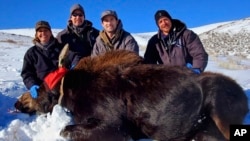In what will be a tiny big-game hunt for some of the largest animals in North America, Nevada is planning its first-ever moose hunting season this fall.
Wildlife managers say explosive growth in Nevada moose numbers over the past five years, increasing to a population of more than 100, justifies the handful of harvests planned.
Scientists say the experiment of sorts should also provide a real-time peek at how the complexities of climate change affect wildlife, and why these majestic — some say goofy-looking — mammals the size of a horse have unexpectedly expanded their range into warmer territory.
"Moose are newcomers to North America," said Cody McKee, a Nevada Department of Wildlife specialist.
The last deer species to cross the Bering Sea land bridge into Alaska and Canada, McKee said the movement of moose into the Lower 48 has occurred almost exclusively in the past 150 years.
"Their post-glacial range expansion isn't really complete," McKee said. "And that's what we're currently seeing in Nevada right now, is those moose are moving into the state and finding suitable habitat."
Only a few Nevada moose, perhaps just one, will be killed across an area larger than Massachusetts and New Jersey combined. But state officials expect thousands of applications for the handful of hunting tags, and it's already controversial.
"Why a moose hunt at all?" Stephanie Myers of Las Vegas asked at a recent wildlife commission meeting. "We want to see moose, view moose. Not kill moose."
The first moose was spotted in Nevada in the 1950s, not long before the dim-witted cartoon character Bullwinkle made his television debut. Only a handful of sightings followed for decades but started increasing about 10 years ago.
By 2018, officials estimated there were 30 to 50, all in Nevada's northeast corner. But the population has more than doubled and experts believe there's enough habitat to sustain about 200, a level that could be reached in three years.
Bryan Bird, Defenders of Wildlife's Southwest program director, is among the skeptics who suspect it's a short-lived phenomenon.
"I believe the moose story is one of 'ghost' habitat or 'ghost' range expansion. By that I mean, these animals are expanding into habitat that may not be suitable in 50 years due to climate change," Bird said.
Government biologists admit they don't fully understand why the moose have moved so far south, where seasonal conditions are warmer and drier than they traditionally prefer.
